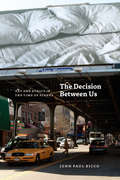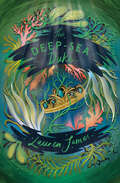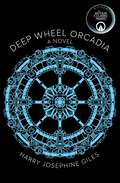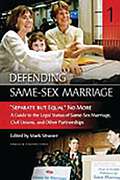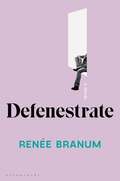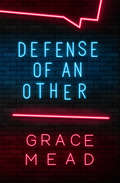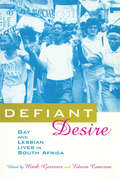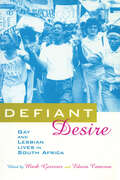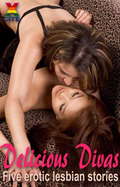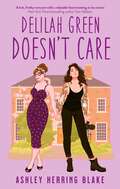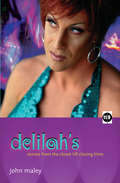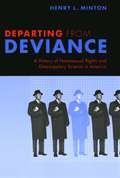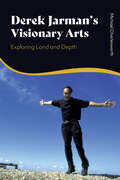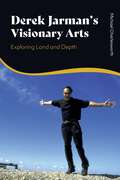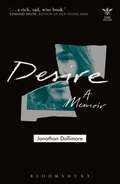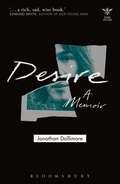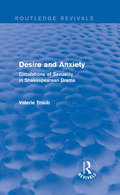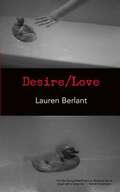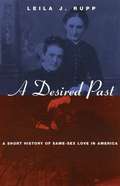- Table View
- List View
The Decision Between Us: Art and Ethics in the Time of Scenes
by John Paul RiccoThe Decision Between Us combines an inventive reading of Jean-Luc Nancy with queer theoretical concerns to argue that while scenes of intimacy are spaces of sharing, they are also spaces of separation. John Paul Ricco shows that this tension informs our efforts to coexist ethically and politically, an experience of sharing and separation that informs any decision. Using this incongruous relation of intimate separation, Ricco goes on to propose that “decision” is as much an aesthetic as it is an ethical construct, and one that is always defined in terms of our relations to loss, absence, departure, and death. Laying out this theory of “unbecoming community” in modern and contemporary art, literature, and philosophy, and calling our attention to such things as blank sheets of paper, images of unmade beds, and the spaces around bodies, The Decision Between Us opens in 1953, when Robert Rauschenberg famously erased a drawing by Willem de Kooning, and Roland Barthes published Writing Degree Zero, then moves to 1980 and the “neutral mourning” of Barthes’ Camera Lucida, and ends in the early 1990s with installations by Felix Gonzalez-Torres. Offering surprising new considerations of these and other seminal works of art and theory by Jean Genet, Marguerite Duras, and Catherine Breillat, The Decision Between Us is a highly original and unusually imaginative exploration of the spaces between us, arousing and evoking an infinite and profound sense of sharing in scenes of passionate, erotic pleasure as well as deep loss and mourning.
The Decision Between Us: Art and Ethics in the Time of Scenes
by John Paul RiccoThe Decision Between Us combines an inventive reading of Jean-Luc Nancy with queer theoretical concerns to argue that while scenes of intimacy are spaces of sharing, they are also spaces of separation. John Paul Ricco shows that this tension informs our efforts to coexist ethically and politically, an experience of sharing and separation that informs any decision. Using this incongruous relation of intimate separation, Ricco goes on to propose that “decision” is as much an aesthetic as it is an ethical construct, and one that is always defined in terms of our relations to loss, absence, departure, and death. Laying out this theory of “unbecoming community” in modern and contemporary art, literature, and philosophy, and calling our attention to such things as blank sheets of paper, images of unmade beds, and the spaces around bodies, The Decision Between Us opens in 1953, when Robert Rauschenberg famously erased a drawing by Willem de Kooning, and Roland Barthes published Writing Degree Zero, then moves to 1980 and the “neutral mourning” of Barthes’ Camera Lucida, and ends in the early 1990s with installations by Felix Gonzalez-Torres. Offering surprising new considerations of these and other seminal works of art and theory by Jean Genet, Marguerite Duras, and Catherine Breillat, The Decision Between Us is a highly original and unusually imaginative exploration of the spaces between us, arousing and evoking an infinite and profound sense of sharing in scenes of passionate, erotic pleasure as well as deep loss and mourning.
The Decision Between Us: Art and Ethics in the Time of Scenes
by John Paul RiccoThe Decision Between Us combines an inventive reading of Jean-Luc Nancy with queer theoretical concerns to argue that while scenes of intimacy are spaces of sharing, they are also spaces of separation. John Paul Ricco shows that this tension informs our efforts to coexist ethically and politically, an experience of sharing and separation that informs any decision. Using this incongruous relation of intimate separation, Ricco goes on to propose that “decision” is as much an aesthetic as it is an ethical construct, and one that is always defined in terms of our relations to loss, absence, departure, and death. Laying out this theory of “unbecoming community” in modern and contemporary art, literature, and philosophy, and calling our attention to such things as blank sheets of paper, images of unmade beds, and the spaces around bodies, The Decision Between Us opens in 1953, when Robert Rauschenberg famously erased a drawing by Willem de Kooning, and Roland Barthes published Writing Degree Zero, then moves to 1980 and the “neutral mourning” of Barthes’ Camera Lucida, and ends in the early 1990s with installations by Felix Gonzalez-Torres. Offering surprising new considerations of these and other seminal works of art and theory by Jean Genet, Marguerite Duras, and Catherine Breillat, The Decision Between Us is a highly original and unusually imaginative exploration of the spaces between us, arousing and evoking an infinite and profound sense of sharing in scenes of passionate, erotic pleasure as well as deep loss and mourning.
The Decision Between Us: Art and Ethics in the Time of Scenes
by John Paul RiccoThe Decision Between Us combines an inventive reading of Jean-Luc Nancy with queer theoretical concerns to argue that while scenes of intimacy are spaces of sharing, they are also spaces of separation. John Paul Ricco shows that this tension informs our efforts to coexist ethically and politically, an experience of sharing and separation that informs any decision. Using this incongruous relation of intimate separation, Ricco goes on to propose that “decision” is as much an aesthetic as it is an ethical construct, and one that is always defined in terms of our relations to loss, absence, departure, and death. Laying out this theory of “unbecoming community” in modern and contemporary art, literature, and philosophy, and calling our attention to such things as blank sheets of paper, images of unmade beds, and the spaces around bodies, The Decision Between Us opens in 1953, when Robert Rauschenberg famously erased a drawing by Willem de Kooning, and Roland Barthes published Writing Degree Zero, then moves to 1980 and the “neutral mourning” of Barthes’ Camera Lucida, and ends in the early 1990s with installations by Felix Gonzalez-Torres. Offering surprising new considerations of these and other seminal works of art and theory by Jean Genet, Marguerite Duras, and Catherine Breillat, The Decision Between Us is a highly original and unusually imaginative exploration of the spaces between us, arousing and evoking an infinite and profound sense of sharing in scenes of passionate, erotic pleasure as well as deep loss and mourning.
The Deep-Sea Duke
by Lauren JamesLauren James dives into a strange new world with a truly imaginative look at the climate crisis in this breathtaking companion to The Starlight Watchmaker.
Deep Wheel Orcadia: A Novel
by Harry Josephine GilesAstrid is returning home from art school on Mars, looking for inspiration. Darling is fleeing a life that never fit, searching for somewhere to hide. They meet on Deep Wheel Orcadia, a distant space station struggling for survival as the pace of change threatens to leave the community behind.Deep Wheel Orcadia is a magical first: a science-fiction verse-novel written in the Orkney dialect. This unique adventure in minority language poetry comes with a parallel translation into playful and vivid English, so the reader will miss no nuance of the original. The rich and varied cast weaves a compelling, lyric and effortlessly readable story around place and belonging, work and economy, generation and gender politics, love and desire – all with the lightness of touch, fluency and musicality one might expect of one the most talented poets to have emerged from Scotland in recent years. Hailing from Orkney, Harry Josephine Giles is widely known as a fine poet and spellbindingly original performer of their own work; Deep Wheel Orcadia now strikes out into audacious new space.
Defending Same-Sex Marriage [3 volumes]: [3 volumes]
by Martin Dupuis William A. Thompson Traci C. WestToday we find ourselves at a crossroads of two powerful, unrelenting currents that are completely at odds with one another. The movement for legal recognition of same-sex unions has gone beyond the separate but equal status of civil unions to demand equality in marriage for all couples. Progress is being made on many fronts: mayoral action, clergy officiating at same-sex marriage and union ceremonies, state legislative responses, and street protests, to name a few. Meanwhile, opposition to same-sex marriage has also been gathering strength. The struggle is sure to continue unabated for some time to come, pitting those who believe in the traditional definition of marriage as a union between a man and a woman—and who seek to codify this belief in the U.S. Constitution—against those who find the basis for marriage between two loving, committed individuals not only in the history of our civil rights legislation and court decisions, but also in scripture and sacred religious traditions. Those who believe in extending to same-sex couples the 1,049 rights conferred by marriage as well as the supportive embrace of religious communities seek to strengthen the institution of marriage by making it inclusive and by passing laws and broadening doctrines to uphold marriage rights for all couples. This three-volume set clarifies the legal, political, religious, cultural, and social ramifications of same-sex marriage for gay and lesbian couples and their families and friends, and for the general public interested in the future of civil rights in the United States.
Defenestrate
by Renée BranumAn exuberant, wildly inventive debut about a young woman fascinated by her ancestors' legendary "falling curse" and trying to keep her own family from falling apart.Marta and her twin brother Nick have always been haunted and fascinated by an ancestral legend that holds that members of their family are doomed to various types of falls. And when their own family collapses in the wake of a revelation and a resulting devastating fight with their Catholic mother, the twins move to Prague, the city in which their “falling curse” began. There, Marta and Nick try to forge a new life for themselves. But their ties to the past and each other prove difficult to disentangle, and when they ultimately return to their midwestern home and Nick falls from a balcony himself, Marta is forced to confront the truths they've hidden from each other and themselves.Ingeniously and unforgettably narrated by Marta as she reflects on all the ways there are to fall--from defenestration in nineteenth century Prague to the pratfalls of her childhood idol Buster Keaton, from falling in love to falling midflight from an airplane--Defenestrate is a deeply original, gorgeous novel about the power of stories and the strange, malleable bonds that hold families together.
Defense Of An Other
by Grace MeadDefense of an Other begins in the French Quarter with a day in the life of a young lawyer named Matt Durant gone horribly awry. After a few beers, Matt works up the courage to visit a gay bar, where he meets a stranger named Joey Buckner. When Matt and Joey duck into an alley behind the bar to take a leak, three drunks target them for a hate crime and beat up Joey, which forces Matt to attack and kill one of the men. Matt is then arrested for murder, thrown in Orleans Parish Prison and calls his boss for help, forcing him out of the closet. The novel then follows the course of his trial and explores its consequences. Defense of an Other is the debut novel from a trans, practicing lawyer born and raised in Louisiana, who graduated from Dartmouth College and then became the Editor-in-Chief of the University of Chicago Law Review. Her seventeen year career has included a one-year clerkship for the appellate court with jurisdiction over Louisiana federal trial courts and 16 years of civil litigation. Heavily influenced by political fiction like Bryce Courtenay’s The Power of One, in Defense of an Other southern storytelling meets the gritty legal realism of Law & Order.
Defiant Desire: Gay and Lesbian Lives in South Africa
by Edwin Cameron Mark GevisserDefiant Desire records the lives of lesbian and gay South Africans of all races as they have lived in the face of censure, denial and oppression. The history of gay identity in South Africa is here in its past and present aspects: from a drag salon in Woodstock to a gay "shebeen" in kwaThema; from a church in a Pretoria nightclub to Johannesburg's lesbian and gay pride march; from Afrikaans love poetry to new activism. The book is a document of lesbian and gay struggle, and indispensable for those interested in the sexual politics coursing beneath the country's troubled passage to democracy.
Defiant Desire: Gay and Lesbian Lives in South Africa
by Mark Gevisser Edwin CameronDefiant Desire records the lives of lesbian and gay South Africans of all races as they have lived in the face of censure, denial and oppression. The history of gay identity in South Africa is here in its past and present aspects: from a drag salon in Woodstock to a gay "shebeen" in kwaThema; from a church in a Pretoria nightclub to Johannesburg's lesbian and gay pride march; from Afrikaans love poetry to new activism. The book is a document of lesbian and gay struggle, and indispensable for those interested in the sexual politics coursing beneath the country's troubled passage to democracy.
Delicious Divas: Five erotic lesbian stories
by Evan RossBells and Lemon Drops by Evan RossTanya is holidaying in San Juan with three friends from work. Sing and Marly are straight and Advit thinks she might be bisexual - which is great, because Tanya secretly hopes to make Advit her love connection. At the hotel, things go unexpectedly wrong when Sing insists on sleeping in the bed with Advit, forcing Tanya to sleep with Marly. She thinks the situation can't get any worse, until it does. Advit will have to get a clue and Tanya must take a risk - before they can stoke their passion and leap into the fires of love.Burnt Sugar by Anna SansomSwapping my usual Saturday night out in a dyke bar with a bottle of beer for a world of feather boas and cocktails was really stepping outside of my comfort zone. Along with the rest of the audience, I hoped to find the burlesque show entertaining and, with any luck, maybe even slightly titillating. But what happened on the stage paled in comparison to meeting my own, private dancer...Wedding by Jess MurrayAttending her ex-boyfriend's wedding becomes much more exciting for blonde Jess when she catches sight of a gorgeous, toned, shorthaired woman. Is she even gay? Jess is determined to find out, and parades her considerable assets to try and turn the mystery woman's head. Once the two of them strike up a conversation it's clear that Jess has more than met her match, and the heat builds as they drink, dance, and banter their way towards a sizzling midnight date in the wedding chapel...Dreams Come True by Encarnita RoundThere is only one woman in the world Ali wants to be with, and that's Sam, her lifelong best friend. Just one party ruins everything and their relationship is broken beyond repair. Rejected and broken hearted, Ali finally decides to pick up the pieces and move on. She seeks a night of distractions, hot and steamy distractions, when she finds that a spilt drink can lead to more than just her trousers getting wet. For Ali, things will never be the same again.Inside Out by Persha BellAt the Flor de Canela Villas complex, everyone's a wannabe, waiting for that big Hollywood break and trading on a vague resemblance to someone more famous. And for D, the dream is turning very sour very quickly. But when D's neighbour breaks up with his celebrity girlfriend, D gets the chance to offer consolation and maybe even find out what it's like to be somebody...A collection of the winning entries from the Xcite/Diva magazine short story competition.
Delilah Green Doesn't Care: A swoon-worthy, laugh-out-loud queer romcom
by Ashley Herring BlakeA clever and steamy queer romantic comedy about taking chances and accepting love - with all its complications. Perfect for fans of Alexandria Bellefleur, Casey McQuiston and Rosie Danan.Delilah Green swore she would never go back to Bright Falls - nothing is there for her except memories of a lonely childhood. Her life now is in New York, with her photography career finally gaining steam and her bed never empty. Sure, it's a different woman every night, but that's just fine with her.When Delilah's estranged stepsister pressures her into photographing her wedding with a guilt trip and a large check, Delilah finds herself back in Bright Falls once more. She plans to breeze in and out, but then she sees Claire Sutherland, one of Astrid's stuck-up besties, and decides that maybe there's some fun (and a little retribution) to be had, after all.Having raised her daughter mostly on her own while dealing with her unreliable ex and running a bookstore, Claire depends upon a life without surprises. And Delilah Green is an unwelcome surprise . . . at first. Though they've known each other for years, they don't really know each other - so Claire is unsettled when Delilah figures out exactly what buttons to push. And when they're forced together during the many wedding preparations, Claire isn't sure she has the strength to resist Delilah's charms. Even worse, she's starting to think she doesn't want to . . .Why readers love Delilah Green...'A hot, frothy romcom with a relatable heart beating at its centre. I loved every hilarious character, every outrageous shenanigan - and most of all, I loved Delilah Green. I can't wait for the rest of the series!' Talia Hibbert, New York Times bestselling author of Act Your Age, Eve Brown'A truly exquisite romance about second chances, new beginnings, and the fragile joy of letting people in. I'm wildly in love with this book' Rachel Lynn Solomon, author of The Ex Talk'A classic in the making, Ashely's adult debut is a warm welcome home from the first page. A swoon-worthy, laugh-out-loud romp of a romance' Kosoko Jackson, author of I'm So Not Over You'A spectacular debut brimming with yearning, swooning, and healing. Delilah Green Doesn't Care reads the way realizing your crush likes you back feels. Ashley Herring Blake is a romance star on the rise' Rosie Danan, bestselling author of The Roommate'Delilah Green Doesn't Care is the dreamy, steamy, utterly satisfying answer to your craving for an outcast-and-former-mean-girl romance. And let's not forget the snappy banter and seriously scorching chemistry; you'll need a very cold shower after this read!' Lana Harper, author of Payback's a Witch'Charming and entertaining, Delilah Green Doesn't Care entrances the reader with the redemptive power of love. Blake's masterful blend of sexual tension and growing affection will have readers swooning' Karelia Stetz-Waters, author of Satisfaction Guaranteed'What an absolute joy to read! Snarky, steamy, and swoony in equal measure, I never wanted this book to end, but there's an easy momentum to Blake's writing that made it impossible to put down' Meryl Wilsner, author of Something to Talk About
Delilah's: stories from the closet till closing time
by John MaleyGlasgow is full of invisible lovers because it's a city where it's hard to be gay. Couples can't easily kiss in the park. They pretend for years to their families that their partner's 'a friend'. And families find it hard to accept that 'friend' - so many people never come out. Some folk look for one-night stands, others can't get anything else. But at Delilah's it's OK to be who you are, as long as you're honest. It's a happy place, always party time, and this is the book where you'll meet Joanie, the bar manager, Mamma and Papa, and all the regulars, as well as those passing through, because at Delilah's no one is invisible. From the big-hearted to the big-haired, Delilah's is in sympathy with the gay community, but with a lot of laughs.
Departing from Deviance: A History of Homosexual Rights and Emancipatory Science in America
by Henry L. MintonThe struggle to remove the stigma of sickness surrounding same-sex love has a long history. In 1973, the American Psychiatric Association removed homosexuality from its diagnostic classification of mental illness, but the groundwork for this pivotal decision was laid decades earlier. In this new study, Henry L. Minton looks back at the struggle of the American gay and lesbian activists who chose scientific research as a path for advancing homosexual rights. He traces the history of gay and lesbian emancipatory research from its early beginnings in the late nineteenth century to its role in challenging the illness model in the 1970s. By examining archival sources and unpublished manuscripts, Minton reveals the substantial accomplishments made by key researchers and relates their life stories. He also considers the contributions of mainstream sexologists such as Alfred C. Kinsey and Evelyn Hooker, who supported the cause of homosexual rights through the advancement of scientific knowledge. By uncovering this hidden chapter in the story of gay liberation, Departing from Deviance makes an important contribution to both the history of science and the history of sexuality.
Departing from Deviance: A History of Homosexual Rights and Emancipatory Science in America
by Henry L. MintonThe struggle to remove the stigma of sickness surrounding same-sex love has a long history. In 1973, the American Psychiatric Association removed homosexuality from its diagnostic classification of mental illness, but the groundwork for this pivotal decision was laid decades earlier. In this new study, Henry L. Minton looks back at the struggle of the American gay and lesbian activists who chose scientific research as a path for advancing homosexual rights. He traces the history of gay and lesbian emancipatory research from its early beginnings in the late nineteenth century to its role in challenging the illness model in the 1970s. By examining archival sources and unpublished manuscripts, Minton reveals the substantial accomplishments made by key researchers and relates their life stories. He also considers the contributions of mainstream sexologists such as Alfred C. Kinsey and Evelyn Hooker, who supported the cause of homosexual rights through the advancement of scientific knowledge. By uncovering this hidden chapter in the story of gay liberation, Departing from Deviance makes an important contribution to both the history of science and the history of sexuality.
Departing from Deviance: A History of Homosexual Rights and Emancipatory Science in America
by Henry L. MintonThe struggle to remove the stigma of sickness surrounding same-sex love has a long history. In 1973, the American Psychiatric Association removed homosexuality from its diagnostic classification of mental illness, but the groundwork for this pivotal decision was laid decades earlier. In this new study, Henry L. Minton looks back at the struggle of the American gay and lesbian activists who chose scientific research as a path for advancing homosexual rights. He traces the history of gay and lesbian emancipatory research from its early beginnings in the late nineteenth century to its role in challenging the illness model in the 1970s. By examining archival sources and unpublished manuscripts, Minton reveals the substantial accomplishments made by key researchers and relates their life stories. He also considers the contributions of mainstream sexologists such as Alfred C. Kinsey and Evelyn Hooker, who supported the cause of homosexual rights through the advancement of scientific knowledge. By uncovering this hidden chapter in the story of gay liberation, Departing from Deviance makes an important contribution to both the history of science and the history of sexuality.
Derek Jarman’s Visionary Arts: Exploring Land and Depth
by Michael CharlesworthDerek Jarman's place in the history of film is assured by virtue of his vibrant, defiant films that experiment with the very process of film-making and create new forms. His paintings, their excitements and their profundity, are less well known. Michael Charlesworth sheds light on the varied ramifications of Jarman's artistic practice from his years at Prospect Cottage, Dungeness, and provides the first book-length study of his interest in depth psychology. He draws on Jarman's paintings, especially his landscapes from the 1960s and 70s, his multiple series such as 'black' and 'broken glass', GBH, Queer and Evil Queen, and his last Ecstatic Landscapes (1991-3). He also showcases Jarman's excellence as a writer with respect to his memoir, Kicking the Pricks. In a novel approach to Jarman's cinema, selecting films such as Journey to Avebury (1973), Caravaggio (1986), The Garden (1990) and Blue (1993), Charlesworth emphasizes themes and artistry rather than narrative. Exploring the ways in which Jungian and post-Jungian psychology were absorbed into Jarman's varied works, Derek Jarman's Visionary Arts provides a fresh perspective on his painting, film and writing. It celebrates him as one of the major British artists of the late 20th century, engaging with current debates about queer sexualities, environmentalism and climate catastrophe.
Derek Jarman’s Visionary Arts: Exploring Land and Depth
by Michael CharlesworthDerek Jarman's place in the history of film is assured by virtue of his vibrant, defiant films that experiment with the very process of film-making and create new forms. His paintings, their excitements and their profundity, are less well known. Michael Charlesworth sheds light on the varied ramifications of Jarman's artistic practice from his years at Prospect Cottage, Dungeness, and provides the first book-length study of his interest in depth psychology. He draws on Jarman's paintings, especially his landscapes from the 1960s and 70s, his multiple series such as 'black' and 'broken glass', GBH, Queer and Evil Queen, and his last Ecstatic Landscapes (1991-3). He also showcases Jarman's excellence as a writer with respect to his memoir, Kicking the Pricks. In a novel approach to Jarman's cinema, selecting films such as Journey to Avebury (1973), Caravaggio (1986), The Garden (1990) and Blue (1993), Charlesworth emphasizes themes and artistry rather than narrative. Exploring the ways in which Jungian and post-Jungian psychology were absorbed into Jarman's varied works, Derek Jarman's Visionary Arts provides a fresh perspective on his painting, film and writing. It celebrates him as one of the major British artists of the late 20th century, engaging with current debates about queer sexualities, environmentalism and climate catastrophe.
Desire: A Memoir (Beyond Criticism)
by Jonathan DollimoreFifty years after the Sexual Offences Act of 1967 decriminalised homosexual acts, Jonathan Dollimore explores, in, through and beyond the gay sub-cultures of cities like New York, Brighton and Sydney, what the new freedoms meant for him and others in the following decades. He writes honestly and movingly about his teenage attraction to risk and danger; of accidents and escapes; of curiosity as a flight from boredom; of suicidal depression and ecstasy; and, beneath all, of the life of desire haunted and torn by loss.For more than thirty years Jonathan Dollimore has been one of contemporary culture's most influential critics of politics, literature, and sexuality. Desire: A Memoir, a hybrid of autobiography, meditation and philosophical reflection, explores the existential sources of his writing.
Desire: A Memoir (Beyond Criticism)
by Jonathan DollimoreFifty years after the Sexual Offences Act of 1967 decriminalised homosexual acts, Jonathan Dollimore explores, in, through and beyond the gay sub-cultures of cities like New York, Brighton and Sydney, what the new freedoms meant for him and others in the following decades. He writes honestly and movingly about his teenage attraction to risk and danger; of accidents and escapes; of curiosity as a flight from boredom; of suicidal depression and ecstasy; and, beneath all, of the life of desire haunted and torn by loss.For more than thirty years Jonathan Dollimore has been one of contemporary culture's most influential critics of politics, literature, and sexuality. Desire: A Memoir, a hybrid of autobiography, meditation and philosophical reflection, explores the existential sources of his writing.
Desire and Anxiety: Circulations of Sexuality in Shakespearean Drama (Routledge Revivals)
by Valerie TraubIn both feminist theory and Shakespearean criticism, questions of sexuality have consistently been conflated with questions of gender. First published in 1992, this book details the intersections and contradictions between sexuality and gender in the early modern period. Valerie Traub argues that desire and anxiety together constitute the erotic in Shakespearean drama – circulating throughout the dramatic texts, traversing ‘masculine’ and ‘feminine’ sites, eliciting and expressing heterosexual and homoerotic fantasies, embodiments, and fears. This is the first book to present a non-normalizing account of the unconscious and the institutional prerogatives that comprise the erotics of Shakespearean drama. Employing feminist, psychoanalytic, and new historical methods, and using each to interrogate the other, the book synthesises the psychic and the social, the individual and the institutional.
Desire and Anxiety: Circulations of Sexuality in Shakespearean Drama (Routledge Revivals)
by Valerie TraubIn both feminist theory and Shakespearean criticism, questions of sexuality have consistently been conflated with questions of gender. First published in 1992, this book details the intersections and contradictions between sexuality and gender in the early modern period. Valerie Traub argues that desire and anxiety together constitute the erotic in Shakespearean drama – circulating throughout the dramatic texts, traversing ‘masculine’ and ‘feminine’ sites, eliciting and expressing heterosexual and homoerotic fantasies, embodiments, and fears. This is the first book to present a non-normalizing account of the unconscious and the institutional prerogatives that comprise the erotics of Shakespearean drama. Employing feminist, psychoanalytic, and new historical methods, and using each to interrogate the other, the book synthesises the psychic and the social, the individual and the institutional.
Desire/Love
by Lauren Berlant“There is nothing more alienating than having your pleasures disputed by someone with a theory,” writes Lauren Berlant. Yet the ways in which we live sexuality and intimacy have been profoundly shaped by theories — especially psychoanalytic ones, which have helped to place sexuality and desire at the center of the modern story about what a person is and how her history should be read. At the same time, other modes of explanation have been offered by popular and mass culture. In these domains, sexual desire is not deemed the core story of life; it is mixed up with romance, a particular version of the story of love. In this small theoretical novella-cum-dictionary entry, Lauren Berlant engages love and desire in separate entries. In the first entry, Desire mainly describes the feeling one person has for something else: it is organized by psychoanalytic accounts of attachment, and tells briefly the history of their importance in critical theory and practice. The second entry, on Love, begins with an excursion into fantasy, moving away from the parent-child structure so central to psychoanalysis and looking instead at the centrality of context, environment, and history. The entry on Love describes some workings of romance across personal life and commodity culture, the place where subjects start to think about fantasy on behalf of their actual lives.
A Desired Past: A Short History of Same-Sex Love in America
by Leila J. RuppWith this book, Leila J. Rupp accomplishes what few scholars have even attempted: she combines a vast array of scholarship on supposedly discrete episodes in American history into an entertaining and entirely readable story of same-sex desire across the country and the centuries. "Most extraordinary about Leila J. Rupp's indeed short, two-hundred-page history of 'same-sex love and sexuality' is not that it manages to account for such a variety of individuals, races, and classes or take in such a broad chronological and thematic range, but rather that it does all this with such verve, lucidity, and analytical rigor. . . . [A]n elegant, inspiring survey." —John Howard, Journal of American History
